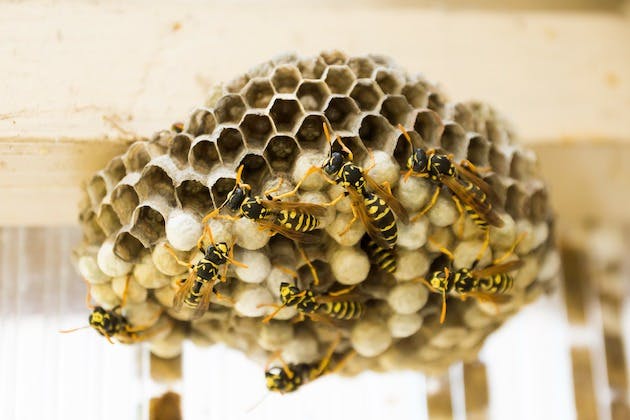No one likes having to deal with a wasp infestation. However, determining when you have a genuine problem might be challenging.
Continue reading this blog post to learn about the warning indications of a wasp infestation.

What are the signs of a wasp infestation?
Noticed a surge of flying insects in your home?
If you continually witness flying insects, you may have a wasp infestation. Wasps are thin and have wings, thus this is an apparent clue. They can also be distinguished by their yellow bodies. The issue with a wasp infestation is that it may go undetected. However, if you notice wasps near your house on a regular basis, you might consider hiring pest control services.
Examining wood in your home for chewed pieces
Check for chewed wood whether you have an exterior wasp infestation or an indoor wasp infestation. This is a warning indication since wasps build their nests by chewing on wood. Look for burrowed holes in wood and similar holes on the outside of your home. In addition to being a symptom of wasp infestation, chewed wood might also be a sign of carpenter ants or termites. Whatever the origin, chewed wood is a serious problem that should be handled by a specialist.
Mud piles
Certain wasp species use mud to build their nests, which result in aesthetically pleasing structures. Unusual mud mounds in and around your house, particularly in shady spots like eaves or corners, may indicate a nest in the process of being built. Keep a close eye on these places because it is easier to control and reduces the chance of stings and structural damage to deal with a wasp infestation early on.
Discreet nesting places
Wasps are sly in their search for locations to construct their nests. It's highly suggestive of a wasp infestation if you find nests in unusual places like crawlspaces, behind wall panels, or inside vents. Because wasps are sly in where they build their nests, it's important to look for evidence of nesting activity in less prominent parts of your property.
Aggressive wasps
An infestation may be indicated by a discernible rise in wasp aggression around your home. There's a thriving colony nearby if wasps become more territorial, become aggressive, or swarm more often. When visiting wasp-infested regions, use caution and think about getting expert help to deal with the infestation safely.
If you’re concerned about an infestation, call us on 07501702101. We offer wasp nest removal in Petersfield, Gosport, Fareham, Portsmouth and the surrounding areas.
How to Find a Wasp Nest
Wasps are astute insects that know how to conceal their nests. A wasp infestation, for example, may occur in a wall. When hunting for the nest, the most essential thing to remember is to step carefully since they will attack if they feel threatened. Nests are usually built of metal or wood, so keep that in mind while you seek. In general, queen wasps establish their nests and lay their first batch of eggs in the spring. The nests are larger by mid-summer and continue to grow over time. If you see wasps flying over your house or yard, pay close attention to where they are going.
You can tell where the nest is by paying attention to the wasps' flying patterns. The crawl space and attic are the most dangerous places for a wasp infestation. If you suspect a wasp nest in these regions, you should contact a specialist immediately.
Dealing with a Wasp Infestation Alone
Noticing wasps around the house and discovering a nest are obvious symptoms of an infestation. It may not always be visible, but if you suspect a wasp infestation, your best choice is to get a professional, like us here at Pegasus Pest Solutions to take care of it. A wasp infestation is not only bothersome, but it may also be harmful.
Contact us today to get rid of your wasp infestation
If you fear that you could have a wasp infestation in your home, and you are local to Fareham, Gosport, Portsmouth, Waterlooville, or any other surrounding areas, then you should give our specialists a call immediately on 07501702101 today!


